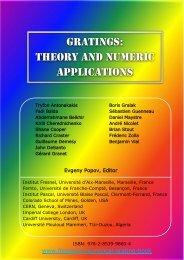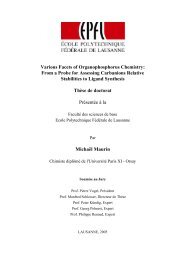12th Carl Zeiss sponsored workshop on ... - Institut Fresnel
12th Carl Zeiss sponsored workshop on ... - Institut Fresnel
12th Carl Zeiss sponsored workshop on ... - Institut Fresnel
Create successful ePaper yourself
Turn your PDF publications into a flip-book with our unique Google optimized e-Paper software.
LIGAND-STIMULATED EGFR CAUSES LIPID DOMAIN-DEPENDENT HIGHER<br />
ORDER AGGREGATION AND INTERNALIZATION OF ERBB2<br />
László<br />
Ujlaky-Nagy,<br />
Árpád Szöır,<br />
János Szöllısi,<br />
György Vereb<br />
University of Debrecen, Dept. of Biophysics and Cell Biology, H-4032 Debrecen (Hungary)<br />
vereb@dote.hu<br />
Members of the ErbB receptor tyrosine kinase family, ErbB1 (EGFR), ErbB2, ErbB3 and<br />
ErbB4, form homo- and heterodimers or higher oligomers with each other which promote cell<br />
survival and proliferati<strong>on</strong> [1]. Generally, overexpressi<strong>on</strong> of the ligandless ErbB2 is thought to<br />
drive homodimer formati<strong>on</strong> in the membrane of tumor cells. However, ErbB2 can also act as a<br />
heterodimerizing partner for other family members, and serve as a signal amplifier for their<br />
ligand-bound forms, which may have clinical relevance in tumors expressing multiple ErbBs<br />
[2]. We have used fluorescence correlati<strong>on</strong> spectroscopy to investigate molecular events of<br />
ErbB1-ErbB2 transactivati<strong>on</strong> in single living SKBR3 breast tumor cells. ErbB2 was labeled<br />
with A488 Fabs. Fluorescence fluctuati<strong>on</strong> traces were taken from single submicr<strong>on</strong> sized spots<br />
in the upper membrane of cells and used to c<strong>on</strong>struct fluorescence autocorrelati<strong>on</strong> spectra.<br />
These were fitted using a model accounting for triplet state, diffusi<strong>on</strong> of dissociated Fabs, as<br />
well as cytoplasmic and membrane (lateral, 2D) diffusi<strong>on</strong> of ErbB2 molecules or their<br />
aggregates. Correlati<strong>on</strong> spectra were obtained every 2.5 min for 1 hour. After 20 min, half of<br />
the samples were stimulated with 50 nM EGF to detect time-dependent changes of ErbB2<br />
diffusi<strong>on</strong>. C<strong>on</strong>trols showed a time dependent fluctuati<strong>on</strong> of membrane diffusi<strong>on</strong> times in the<br />
120-200 ms range (182±9 ms, mean±SEM). This was paralleled with internalizati<strong>on</strong> and<br />
recycling to the surface of receptors as measured by flow cytometry. Membrane diffusi<strong>on</strong> of<br />
ErbB2 was divided into at least two comp<strong>on</strong>ents: a faster comp<strong>on</strong>ent characterizing<br />
m<strong>on</strong>omers or smaller aggregates, and a slower comp<strong>on</strong>ent related to higher oligomers or<br />
larger clusters. The corresp<strong>on</strong>ding diffusi<strong>on</strong> times were 94±3 ms and 360±18 ms. Codiffusi<strong>on</strong><br />
of ErbB2 with ErbB2 up<strong>on</strong> labeling with a mixture of A488 and A647 fluorophors<br />
was detected by fluorescence cross-correlati<strong>on</strong> spectroscopy (FCCS) mainly for the slower<br />
comp<strong>on</strong>ent indicating that the faster comp<strong>on</strong>ent might be biased towards m<strong>on</strong>omers.<br />
Resp<strong>on</strong>ses to EGF stimulati<strong>on</strong> were vastly heterogeneous in timing, but manifested<br />
unanimously in an increase of characteristic average membrane diffusi<strong>on</strong> time to maximally<br />
550±119 ms. The average <strong>on</strong>set of resp<strong>on</strong>se was 5.5 min post stimulus and slowed-down<br />
diffusi<strong>on</strong> was maintained for ~30 min. EGF-induced transactivati<strong>on</strong> did not change the faster<br />
comp<strong>on</strong>ent (100±19 ms), but lead to the increased diffusi<strong>on</strong> times of the slower <strong>on</strong>e (from 360<br />
ms to 764±66 ms), at the same time decreasing its fracti<strong>on</strong>al proporti<strong>on</strong> from 0.55 to 0.2,<br />
while the fast comp<strong>on</strong>ent increased from 0.37 to 0.65. This may be an indirect indicati<strong>on</strong> that<br />
larger aggregates are needed for internalizati<strong>on</strong> and the receptors are recycled as m<strong>on</strong>omers or<br />
smaller clusters afterwards. C<strong>on</strong>sequences of the increased ErbB1-ErbB2 interacti<strong>on</strong> could be<br />
detected by microscopic fluorescence res<strong>on</strong>ance energy transfer as well as from increased<br />
ErbB1 and ErbB2 phosphorylati<strong>on</strong> in Western blots and were decreased by extracti<strong>on</strong> of<br />
membrane cholesterol with methyl-ß-cyclodextrine. This treatment also accelerated the<br />
diffusi<strong>on</strong> time of ErbB2 to 83±16 ms, indicating that the slower comp<strong>on</strong>ent (higher<br />
aggregates) corresp<strong>on</strong>ds to microscopic lipid rafts. Given the low expressi<strong>on</strong> of ErbB1 in<br />
SKBR3 cells, the mechanism of ErbB1-ErbB2 transactivati<strong>on</strong> can be interpreted as ErbB1<br />
serving as signal antennae that up<strong>on</strong> ligand binding recruit ErbB2 to form increasing size<br />
activated aggregates <strong>on</strong> lipid raft platforms that eventually get internalized.<br />
[1] Y. Yarden, M. X. Sliwkowski, Nat Rev Mol Cell Biol. 2 (2001) 127-137.<br />
[2] A. Citri., Y. Yarden, Nat Rev Mol Cell Biol. 7 (2006) 505-516.<br />
12 th <str<strong>on</strong>g>Zeiss</str<strong>on</strong>g> <str<strong>on</strong>g>sp<strong>on</strong>sored</str<strong>on</strong>g> FCS <str<strong>on</strong>g>workshop</str<strong>on</strong>g> – Cargèse, Corsica, France – <str<strong>on</strong>g>12th</str<strong>on</strong>g> -16th October 2009













